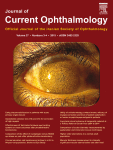Higher order aberrations in a normal adult population
Affiliations
- a
- Noor Research Center for Ophthalmic Epidemiology, Noor Eye Hospital, Tehran, Iran
- b
- Noor Ophthalmology Research Center, Noor Eye Hospital, Tehran, Iran
- c
- Department of Optometry, School of Paramedical Sciences, Mashhad University of Medical Sciences, Mashhad, Iran
- d
- Center for Health Related Social and Behavioral Sciences Research, Shahroud University of Medical Sciences, Shahroud, Iran
- e
- Department of Community Medicine, School of Medicine, Tehran University of Medical Sciences, Tehran, Iran
- f
- Department of Epidemiology and Biostatistics, School of Public Health, Tehran University of Medical Sciences, Tehran, Iran
Abstract
Purpose
To determine the distribution of Zernike coefficients and higher order aberrations in a normal population and its relationship with age, gender, biometric components, and spherical equivalent.
Methods
During the first phase of the Shahroud cohort study, 6311 people of the 40-64-year-old population of Shahroud city were selected through random cluster sampling. A subsample of participants was examined with Zywave aberrometer (The Bausch & Lomb, Rochester, NY) to measure aberrations. Measurements of aberrations were done before cycloplegic refraction, and values generated from a minimum pupil diameter of 5 mm were reported in this analysis.
Results
After applying exclusion criteria, 904 eyes of 577 people were analyzed in this study and mean age in this study was 49.5 ± 5.7 years and 62.9% were female. Mean root-mean-square (RMS) of the third−, fourth−, and fifth-order aberrations was 0.194 μm (95%CI: 0.183 to 0.204), 0.115 μm (95%CI: 0.109 to 0.121), and 0.041 μm (95%CI: 0.039 to 0.043), respectively. Total RMS coma (Z3−1, Z31, Z5−1, Z51), Total RMS trefoil (Z3−3, Z33, Z5−3, Z53), and spherical aberration (Z40) in the studied population was 0.137 μm (95% CI:0.129–0.145), 0.132 μm (95% CI: 0.123–0.140), and −0.161 μm (95%CI:−0.174 to −0.147), respectively. Mean higher-order Zernike RMS in this study was 0.306 (95% CI: 0.295–0.318) micrometer, and in the multiple model, it significantly correlated with older age and short axial length. The highest amounts of higher-order RMS were observed in hyperopes, and the smallest in emmetropes. Increased nuclear opacity was associated with a significant increase in HO RMS (p < 0.001). Analysis of Zernike coefficients demonstrated that spherical aberration (Z40) significantly correlated with nuclear cataract only (age-adjusted Coef = 0.37 and p = 0.012).
Conclusion
This report is the first to describe the distribution of higher-order aberrations in an Iranian population. Higher-order aberrations in this study were on average higher that those reported in previous studies.
Keywords
How to Cite
Higher order aberrations in a normal adult population,
Journal of Current Ophthalmology,
Volume 27, Issues 3–4,
2015,
Pages 115-124,
ISSN 2452-2325,
https://doi.org/10.1016/j.joco.2015.11.002.
(https://www.sciencedirect.com/science/article/pii/S2452232515300329)
Keywords: Zernike coefficients; Higher order aberrations; Population based study; Adult

